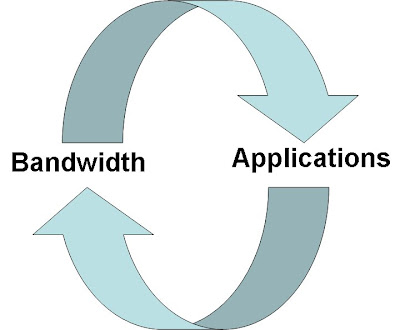Evolution of Applications and Bandwidth
Let's go back in time just a few years. The days when social networking was done in person:-)Think about the dial-up/AOL days. There was not much you could do on the Internet except email and read web pages (Web 1.0). In those days average speed was less than 56kpbs and now the average broadband speeds in the US are between 2Mbps and 5Mbps. Even if you take the lower number i.e. 2Mbps it is 35x increase over what we had 10-12 years ago. The new applications have increased in the same proportions. For example-Youtube, social networking, Grid computing, online gaming, flickr, tagging, blogs, movie downloads, second life, etc. etc. And, Web 1.0 has evolved to Web 2.0. Most of these applications evolved to become popular (widely adopted) because of increased bandwidth availability. Similarly there are applications (mutations) being created today which will evolve to become popular when the bandwidth availability increases from the current levels.

Bandwidth and Applications create an infinite loop i.e. co-evolve. Bandwidth enables the creation of new applications and new applications need more bandwidth to evolve. The additional bandwidth then creates even more new applications which need even more bandwidth to evolve. And so on.
For the first time in history, we have ability to do mass collaboration irrespective of location. Imagine the possibilities it will create. We have only seen the tip of the iceberg.
Some say that making predictions is dangerous especially if it is about the future:-). In 1981 Mr. Bill Gates said, "640K ought to be enough for anybody." I am predicting that in the foreseeable future, the demand for bandwidth will continue to rise as current applications evolve and new applications are born.
What I explained above is millions of year old concept found in biology. Applications-Bandwidth have Predator-Prey relationship. Applications "eat" Bandwidth for survival and they co-evolve. As in biology, the predator species which collaborate get to eat most of the preys, the P2P applications "eat" up to 90% of all bandwidth. P2P (Peer to Peer) is a good example of mass collaboration. Also, as the big (complex) predator species eat more, the complex applications (video) eat more bandwidth. As both applications and bandwidth evolve to adapt to the new environment, the earlier versions for both continue to decline and will eventually die. Dial-up bandwidth connections are on decline and Web 1.0 sites are on decline.
I find it fascinating how the fundamental concepts from one field can be applied to another field. Given enough knowledge, one can develop Universal concepts. This is what Complex Systems (CX) teaches you. To learn more about CX, please visit necsi.org
Your thoughts?

Bandwidth and Applications create an infinite loop i.e. co-evolve. Bandwidth enables the creation of new applications and new applications need more bandwidth to evolve. The additional bandwidth then creates even more new applications which need even more bandwidth to evolve. And so on.
For the first time in history, we have ability to do mass collaboration irrespective of location. Imagine the possibilities it will create. We have only seen the tip of the iceberg.
Some say that making predictions is dangerous especially if it is about the future:-). In 1981 Mr. Bill Gates said, "640K ought to be enough for anybody." I am predicting that in the foreseeable future, the demand for bandwidth will continue to rise as current applications evolve and new applications are born.
What I explained above is millions of year old concept found in biology. Applications-Bandwidth have Predator-Prey relationship. Applications "eat" Bandwidth for survival and they co-evolve. As in biology, the predator species which collaborate get to eat most of the preys, the P2P applications "eat" up to 90% of all bandwidth. P2P (Peer to Peer) is a good example of mass collaboration. Also, as the big (complex) predator species eat more, the complex applications (video) eat more bandwidth. As both applications and bandwidth evolve to adapt to the new environment, the earlier versions for both continue to decline and will eventually die. Dial-up bandwidth connections are on decline and Web 1.0 sites are on decline.
I find it fascinating how the fundamental concepts from one field can be applied to another field. Given enough knowledge, one can develop Universal concepts. This is what Complex Systems (CX) teaches you. To learn more about CX, please visit necsi.org
Your thoughts?
